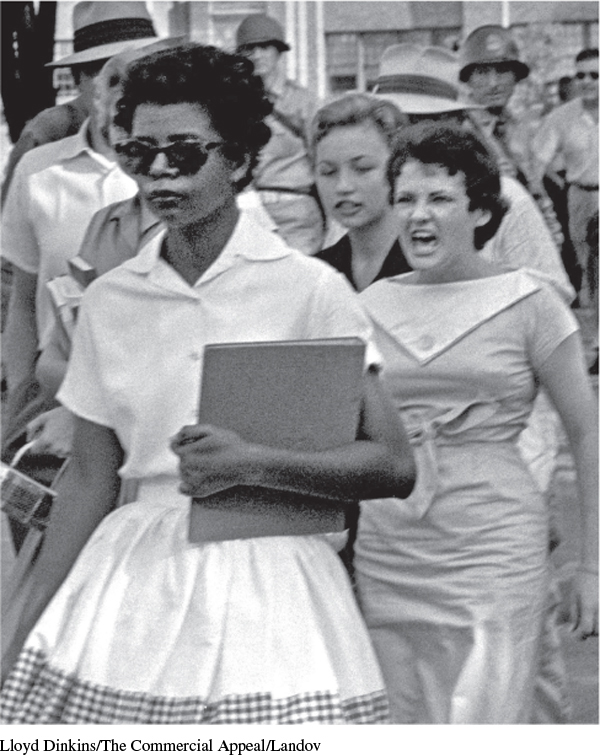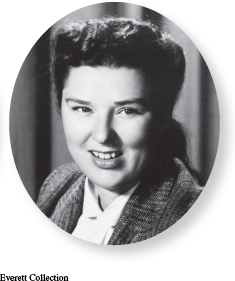Introduction to Chapter 25
25
Troubled Innocence
1945–1961
WINDOW TO THE PAST
The Desegregation of Central High School, 1957

After two decades of economic depression and world war, the 1950s saw a return of peace and prosperity. However, for African Americans the 1950s were a time of challenges and conflicts. This photo of Elizabeth Eckford walking through a hostile crowd in Little Rock, Arkansas, exhibits the dignity of one teenager in the struggle for racial equality. To discover more about what this primary source can show us, see Document 25.7.
LEARNING OBJECTIVES
After reading this chapter you should be able to:
Explain the problems of converting from World War II to peacetime and discuss the causes and effects of the postwar economic boom.
Analyze how the 1950s popular culture reflected the expanding consumer-oriented economy and explain the challenges to mainstream culture posed by teenagers, women, and the Beat generation.
Explore the growth of the civil rights movement and identify the strategies used to challenge segregation and discrimination in the 1950s.
Discuss the impact of President Eisenhower’s domestic policies and accomplishments on the Republican Party and the nation.
AMERICAN HISTORIES

Alan Freed shook up American youth culture in the 1950s by rebranding existing black music and making it popular with white teenagers. In 1951, at the age of twenty-nine, Aldon (Alan) James Freed was spinning records as a disc jockey, or “deejay,” at a Cleveland, Ohio, radio station. He played rhythm and blues, an African American music style considered “race music.” Calling himself Moondog, Freed howled like a dog and used sound effects to rattle his radio listeners. Although he initially appealed mainly to a black audience, Freed’s radio show and live concerts of music he dubbed rock ’n’ roll soon attracted white teenagers.
In 1954 Freed moved to New York City, where his evening rock ’n’ roll radio broadcast became a number one hit. Three years later, he hosted a nationally televised rock ’n’ roll program, but only briefly. The American Broadcasting Company canceled Freed’s show after four telecasts because of outrage from affiliate stations in the South after the black singer Frankie Lymon was shown dancing with a white girl.
The television incident was only the start of Freed’s professional problems. In 1960 Freed was brought before a congressional committee investigating “payola,” a common practice among deejays of receiving gifts from record companies in exchange for playing their records. His career sank further when, in 1962, Freed was convicted of commercial bribery by New York State. Impoverished and struggling with alcoholism, Freed died in 1965 at the age of forty-three.

Like Alan Freed, Grace Metalious sent shock waves through American popular culture in the 1950s. Metalious grew up in poverty in Manchester, New Hampshire. In 1943, while still a teenager, she married and became a mother and housewife. In 1956 Metalious published her first novel, Peyton Place, and the book sold more than three million copies the first year. Considered provocative and racy because of its discussion of sex, rape, and incest, the novel punctured myths about the straitlaced life of small-town America. It criticized small-minded conformity that enforced a double standard of sexual behavior on women.
Despite the book’s popularity, Metalious was never seen as a serious writer. Detractors described her as an untalented author who disseminated filth. Metalious could not reconcile her success with the criticism she received and, like Alan Freed, increasingly turned to alcohol for comfort. In 1964, just eight years after publication of Peyton Place, she died at age thirty-nine of cirrhosis of the liver. Both Metalious and Freed challenged notions of conventional taste, and both found their lives upended by the backlash their work inspired.
The American histories of Alan Freed and Grace Metalious, both of whom attacked conformity, were made possible by the emergence of a mass-consumption economy fueled by technological innovation. The end of World War II had produced economic, social, and political challenges for Americans; however, the economic boom of the 1950s allowed many Americans to overcome them. A large number of families moved into the middle class and out to suburbia. Yet not everyone felt satisfied, and critics expressed their disapproval in diverse ways. Young people challenged their parents’ culture. Writers and musicians experimented with freer forms of artistic expression and attacked the conformity they associated with mainstream America. And African Americans and other minorities challenged racial segregation directly in the Supreme Court and through powerful community protests.
Exploring American HistoriesPrinted Page 823
Exploring American Histories Value EditionPrinted Page 606
Chapter Timeline